Abstract
Because DNA degrades over time, extracting DNA of sufficient quality for sequencing is presumed to be more difficult from older than younger herbarium specimens. Although massive parallel sequencing techniques have clear advantages when it comes to sequencing ancient DNA, Sanger sequencing is still in frequent use, prompting us to test and improve its application on herbarium specimens. During molecular phylogenetic investigations of the subfamily Lamioideae (Lamiaceae) and subgroups, we extracted DNA from 651 herbarium specimens collected between 1826 and 2006 using regular mini-prep methods. The aim was to obtain DNA of sufficient quality for Sanger sequencing of various plastid and nuclear genetic markers. Here, we report successful Sanger sequencing of the commonly used plastid marker, rps16, as a conservative measure of DNA quality, and logistic regression to investigate the relationship between age of the material and DNA quality. Our result indicates that the upper age limit for obtaining DNA suitable for Sanger,sequencing from herbarium specimens using regular mini-prep DNA extraction methods has not been reached. After simple modifications to the regular DNA miniprep and PCR procedures, at least one genetic marker was successfully sequenced for about 90 % of the specimens tested, the oldest being 168 years old. Jointly, despite the technique’s drawbacks, these results demonstrate a high success rate of Sanger sequencing of herbarium specimens.

Dieses Werk steht unter der Lizenz Creative Commons Namensnennung 4.0 International.
Copyright (c) 2023 Mika Bendiksby, Lisbeth Thorbek, Charlotte Bjorå, Rune Halvorsen

